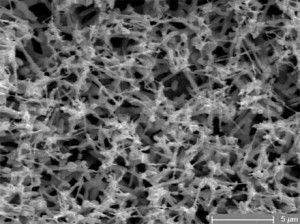Super Lithium-Ion batteries with three times the capacity of today's models, may begin entering the real world within twelve months. That could substantially change consumer and business usage patterns for phones, tablets, laptops, electric vehicles, and a plethora of other devices and gadgets.
[caption id="attachment_5774" align="alignright" width="163"]


The designation of 'Super' is used because those batteries provide triple the energy storage capacity of current lithium-ion batteries. The nanoscale-based technology utilized has the additional benefit of causing the batteries to re-charge far more quickly than current models. An additional benefit is a greatly extended life-cycle. The super lithium-ion types can endure far more recharge cycles than has previously been possible. They can be produced in the same form-factors currently being used, and will have the same appearance. That should make the transition seamless for manufacturers, distributors, retailers, consumers, and business users.
The Super Team Behind the Super Battery
Washington State University researchers led by Grant Norton, a Ph.D. and professor in the School of Mechanical and Materials Engineering have already filed patents on an anode made of tin rather than carbon, the substance currently in use.
Speaking to Parts-People.com by phone and e-mail, Norton said: "This technology offers the potential for a cost-effective, industry-scalable process for next-generation anode materials for lithium-ion batteries." He added, "Our goal is to have a commercially available product using the new anode material within twelve months."
The Technology
[caption id="attachment_5779" align="alignright" width="264"]


At issue is the propensity for tin filaments or whiskers to grow on tin-plated electronics. Those microscopic whiskers create short circuits in microelectronics than can cause catastrophic damage. That's a problem with a sixty year history. Norton and his team of researchers took the approach of trying to control the growth of the tin filaments, instead of trying to eliminate them.
Using a standard electroplating process they developed a method for growing tin nano-needles directly onto copper foil. The result is an end-product that will cost less, look exactly the same as current batteries, and perform far better. That gives end-users batteries with three times the energy capacity, a very short charge time, and far more charge cycles.
This is not ephemeral pie-in-the-sky. Grant Norton's team of researchers have already started building and testing the batteries.
Assessment
Upcoming thin-and-light laptops, tablets, and smartphones are already being designed with far more efficient chip-sets. When super lithium-ion batteries become common-place in mobile devices, it should be possible to go for days without re-charging for many devices, and twenty-four to thirty hours on a charge for 2013 ultrabook and ultrathin laptops.

 Laptop & Tablet Parts
Laptop & Tablet Parts






















One Response to Super Lithium-Ion Battery Could Supercharge Phones, PCs, & Cars